A Sand Boil Database for Piping Risk Management in the Po River, Italy
Abstract
:1. Introduction
2. General Mechanics of Backward Erosion Piping and Predisposing Geologic Factors
3. An Example of a Historical Sand Boil along the Po River
3.1. Boretto Case Study
3.2. Application of Simplified Methods to Assess Piping Susceptibility
4. The Italian Sand Boil Database
4.1. Database Structure
- The river, with the associated hydrometric network providing river flow information. This is used by the flood simulation algorithm to calculate the river level in sections where sand boils are observed during flood events;
- The sand boil, together with the list of high-water events, which is the core of the database.
4.2. Database Query
5. Conclusions
Author Contributions
Funding
Data Availability Statement
Conflicts of Interest
References
- Van Beek, V.M. Backward Erosion Piping. Initiation and Progression. Doctoral Dissertation, Delft University of Technology, Delft, The Netherlands, 2015. Available online: http://repository.tudelft.nl/ (accessed on 5 December 2015).
- Zhou, R.; Wen, Z.; Su, H. Detect submerged piping in river embankment by passive infrared thermography. Measurement 2022, 202, 111873. [Google Scholar] [CrossRef]
- US Army Corps of Engineers. Investigation of Underseepage and Its Control—Lowser Mississippi River Levees; Technical Memorandum No. 3-424; Waterways Experiment Station: Vicksburg, MS, USA, 1956; Volume 1. [Google Scholar]
- US Army Corps of Engineers. Performance Evaluation of the New Orleans and Southeast Louisiana Hurricane Protection System; Final Report of the Interagency Performance Evaluation Task Force; US Army Corps of Engineers: Washington, DC, USA, 2009; Volume 1. [Google Scholar]
- Po River Basin Authority. Progetto Strategico per il Miglioramento delle Condizioni di Sicurezza Idraulica dei Territori di Pianura Lungo l’Asta Medio-Inferiore del Fiume Po; Technical Report; Po River Basin Authority: Parma, Italy, 2005; p. 88. (In Italian) [Google Scholar]
- ICOLD. Internal Erosion of Existing Dams, Levees and Dikes, and Their Foundations; Bulletin 164; ICOLD: Paris, France, 2015; p. 342. [Google Scholar]
- Robbins, B.A.; Van Beek, V.M. Backward erosion piping: A historical review and discussion of influential factors. In Proceedings of the ASDSO Dam Safety Conference, New Orleans, LA, USA, 13–17 September 2015; pp. 1–20. [Google Scholar]
- DeHaan, H.; Stamper, J.; Walters, B. Mississippi River and Tributaries System. 2011 Post-Flood Report; USACE, Mississippi Valley Division: Vicksburg, MS, USA, 2012. [Google Scholar]
- Kelley, J.R.; Parkman, K.B.; Strange, R.C.; Breland, B.R.; Dunbar, J.B.; Corcoran, M.K. Investigation of Sand Boils near Ware, IL, Middle Mississippi River, Preston Levee District; Report No. ERDC/GSL TR-19-36; USACE, Engineer Research and Development Center: Vicksburg, MS, USA, 2019. [Google Scholar]
- ÉDUVIZIG. Report on the Latest Reactivations of Sand Boils, including New Geological and Geotechnical Data to be Added to Existing Database (Danube and Marcal River Basins); Technical Report, LIFE19 ENV/IT/000071—LIFE SandBoil; ÉDUVIZIG: Győr, Hungary, 2021; p. 16. [Google Scholar]
- Marchi, M.; García Martínez, M.F.; Gottardi, G.; Tonni, L. Field measurements on a large natural sand boil along the river Po, Italy. Q. J. Eng. Geol. Hydrogeol. 2021, 54, qjegh2020-097. [Google Scholar] [CrossRef]
- Van Beek, V.; Wiersma, A.; Van Egdom, M.; Robbins, B.A. Databases for Backward Erosion Piping Laboratory Experiments and Field Observations. In Proceedings of the EWG-IE 26th Annual Meeting 2018, Milan, Italy, 10–13 September 2018; Springer: Cham, Switzerland, 2019; pp. 336–346. [Google Scholar]
- Aielli, S.; Pavan, S.; Parodi, S.; Rosso, A.; Tanda, M.G.; Marchi, M.; Vezzoli, G.; Pantano, A.; Losa, D.; Sirtori, M. Collection and analysis of the reactivation data of the historical sand boils in the Po river levees. In Proceedings of the EWG-IE 26th Annual Meeting 2018, Milan, Italy, 10–13 September 2018; Springer: Cham, Switzerland, 2019; pp. 327–335. [Google Scholar]
- Zhou, Q.; Su, J.; Arnbjerg-Nielsen, K.; Ren, Y.; Luo, J.; Ye, Z.; Feng, J. A GIS-based hydrological Modeling Approach for Rapid Urban Flood Hazard Assessment. Water 2021, 13, 1483. [Google Scholar] [CrossRef]
- Dirkx, W.-J.; van Beek, R.; Bierkens, M. The Influence of Grain Size Distribution on the Hydraulic Gradient for Initiating Backward Erosion. Water 2020, 12, 2644. [Google Scholar] [CrossRef]
- Pan, H.; Rice, J.D.; Peng, S.; Cao, H.; Luo, G. Analytical Modeling with Laboratory Data and Observations of the Mechanisms of Backward Erosion Piping Development. Water 2022, 14, 3420. [Google Scholar] [CrossRef]
- Riha, J.; Petrula, L. Experimental Research on Backward Erosion Piping Progression. Water 2023, 15, 2749. [Google Scholar] [CrossRef]
- Kolb, C.R. Geologic Control of Sand Boils along Mississippi River Levees; Final Report, Miscellaneous Paper S-75-22; Soils and Pavements Laboratory, U.S. Army Engineer Waterways Experiment Station: Vicksburg, MS, USA, 1975. [Google Scholar]
- Semmens, S.N.; Zhou, W. Evaluation of environmental predictors for sand boil formation: Rhine-Meuse Delta, Netherlands. Environ. Earth Sci. 2019, 78, 457. [Google Scholar] [CrossRef]
- Girolami, L.; Bonelli, S.; Valois, R.; Chaouch, N.; Burgat, J. On internal erosion of the pervious foundation of flood protection dikes. Water 2023, 15, 3747. [Google Scholar] [CrossRef]
- Arfa-Fathollahkhani, A.; Ayyoubzadeh, S.A.; Shafizadeh-Moghadam, H.; Mianabadi, H. Spatiotemporal Characterization and Analysis of River Morphology Using Long-Term Landsat Imagery and Stream Power. Water 2022, 14, 3656. [Google Scholar] [CrossRef]
- Downard, A.D.; Semmens, S.N.; Robbins, B.A. Automated Characterization of Ridge-Swale Patterns along the Mississippi River; Report ERDC/GSL TR-21-13; Engineer Research and Development Center, US Army Corps of Engineers: Washington, DC, USA, 2021. [Google Scholar]
- Martin, S.M.; Dunbar, J.B.; Corcoran, M.K.; Schmitz, D.W. Geologic Controls of Sand Boil Formation at Buck Chute, Mississippi; Report ERDC/GSL TR-17-12; Engineer Research and Development Center, US Army Corps of Engineers: Washington, DC, USA, 2017. [Google Scholar]
- Castaldini, D.; Marchetti, M.; Norini, G.; Vandelli, V.; Zuluaga Vélez, M.C. Geomorphology of the central Po Plain, Northern Italy. J. Maps 2019, 15, 780–787. [Google Scholar] [CrossRef]
- Campo, B.; Amorosi, A.; Bruno, L. Contrasting alluvial architecture of Late Pleistocene and Holocene deposits along a 120-km transect from the central Po Plain (northern Italy). Sediment. Geol. 2016, 341, 265–275. [Google Scholar] [CrossRef]
- Rosselli, S.; Molinari, F.C.; Severi, P. Note Illustrative della Carta Geologica d’Italia alla Scala 1:50,000, Foglio 182 Guastalla; Regione Emilia-Romagna, Servizio Geologico, Sismico e dei Suoli: Bologna, Italy; p. 95. Available online: https://www.isprambiente.gov.it/Media/carg/note_illustrative/182_Guastalla.pdf (accessed on 15 March 2024).
- Gottardi, G.; Marchi, M.; Tonni, L. Static stability of Po river banks on a wide area. In Geotechnical Engineering for Infrastructure and Development, Proceedings of the XVI ECSMGE, Edimburgh, UK, 13–17 September 2015; ICE Publishing: London, UK, 2015; Volume 4, pp. 1675–1680. [Google Scholar]
- Merli, C.; Colombo, A.; Riani, C.; Rosso, A.; Martelli, L.; Rosselli, S.; Severi, P.; Biavati, G.; De Andrea, S.; Fossati, D.; et al. Seismic stability analyses of the Po river banks. In Proceedings of the XII IAEG, Torino, Italy, 15–19 September 2014; Springer: Cham, Switzerland, 2014; Volume 2, pp. 877–880. [Google Scholar]
- Martelli, L.; Severi, P.; Biavati, G.; Rosselli, S. Modello Geologico per le Verifiche di Stabilità in Condizioni Sismiche dell’argine Destro del Po tra Boretto (RE) e Ro (FE); Report SISMAPO; Regione Emilia-Romagna—Servizio Geologico, Sismico e dei Suoli: Bologna, Italy, 2011; p. 21. [Google Scholar]
- Robertson, P.K. Estimating in-situ soil permeability from CPT & CPTu. In Proceedings of the 2nd International Symposium on Cone Penetration Testing, CPT’10, Huntington Beach, CA, USA, 9–11 May 2010; Volume 1. [Google Scholar]
- Bertolini, I.; Gottardi, G.; Marchi, M.; Tonni, L.; Bassi, A.; Rosso, A. Application of CPT to the evaluation of permeability in a Po river embankment prone to backward erosion piping. In Proceedings of the 5th International Symposium on Cone Penetration Testing (CPT’22), Bologna, Italy, 8–10 June 2022; CRC Press: Leiden, The Netherlands, 2022; pp. 300–305. [Google Scholar] [CrossRef]
- Gottardi, G.; Gragnano, C.G.; Ranalli, M.; Tonni, L. Reliability analysis of riverbank stability accounting for the intrinsic variability of unsaturated soil parameters. Struct. Saf. 2020, 86, 101973. [Google Scholar] [CrossRef]
- Severi, P.; Biavati, G. Definizione del Modello Geologico e Idrogeologico della Zona Arginale del Fiume Po in Destra Idrografica da Boretto (RE) a Ro (FE); Servizio Geologico, Sismico e dei Suoli, Regione Emilia-Romagna: Bologna, Italy, 2013. (In Italian) [Google Scholar]
- CIRIA. The International Levee Handbook; CIRIA: London, UK, 2013. [Google Scholar]
- US Army Corps of Engineers. Design and Construction of Levees; Engineer Manual 1110-2-1913; US Army Corps of Engineers: Washington, DC, USA, 2000. [Google Scholar]
- García Martínez, M.F.; Tonni, L.; Marchi, M.; Tozzi, S.; Gottardi, G. A numerical tool for the prediction of sand boil reactivations near river embankments. J. Geotech. Geoenviron. Eng. 2020, 146, 06020023. [Google Scholar] [CrossRef]
- Sellmeijer, J.B. On the Mechanism of Piping under Impervious Structures. Doctoral Dissertation, Technical University of Delft, Delft, The Netherlands, 1988. [Google Scholar]
- Sellmeijer, J.B.; Koenders, M.A. A mathematical model for piping. Appl. Math. Model. 1991, 15, 646–651. [Google Scholar] [CrossRef]
- Sellmeijer, J.B.; Lopéz de la Cruz, J.; Van Beek, V.M.; Knoeff, J.G. Fine-tuning of the piping model through small-scale, medium-scale and IJkdijk experiments. Eur. J. Environ. Civ. Eng. 2011, 15, 1139–1154. [Google Scholar] [CrossRef]
- Hortus. Sand Boil Management: User Manual; Hortus: Longiano, Italy, 2021. [Google Scholar]
- AIPO. Report on the Latest Reactivations of Sand Boils, including New Geological and Geothechnical Data to be Added to Existing Database (Po River Basin); LIFE SandBoil (LIFE19 ENV/IT/000071): Deliverable 1—Action A1 Update of the sand boil databases for the Po and Danube rivers; AIPO: Parma, Italy, 2021. [Google Scholar]
- Kuchi, A.; Hoque, M.T.; Abdelguerfi, M.; Flanagin, M.C. Machine learning applications in detecting sand boils from images. Array 2019, 3–4, 100012. [Google Scholar] [CrossRef]
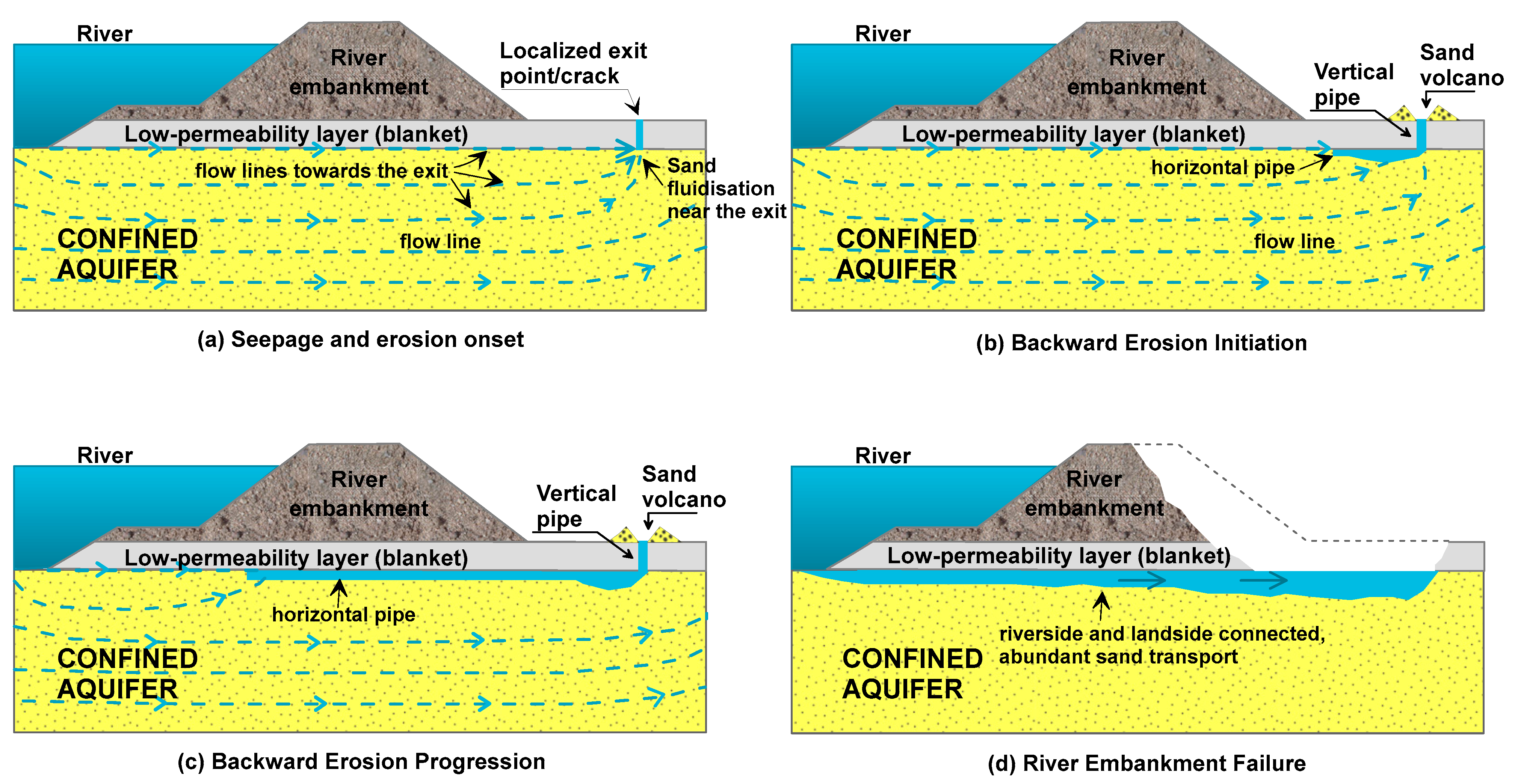

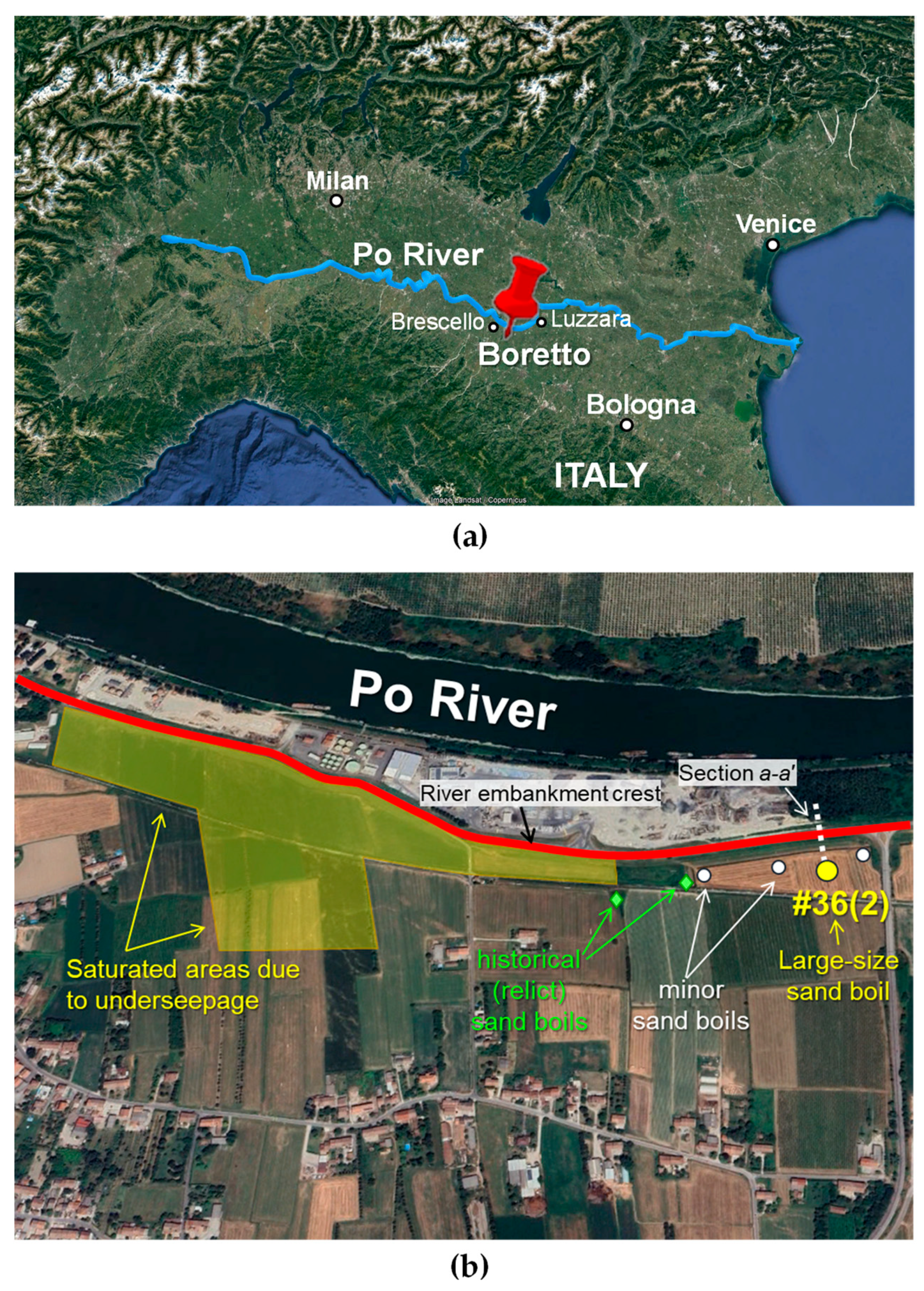

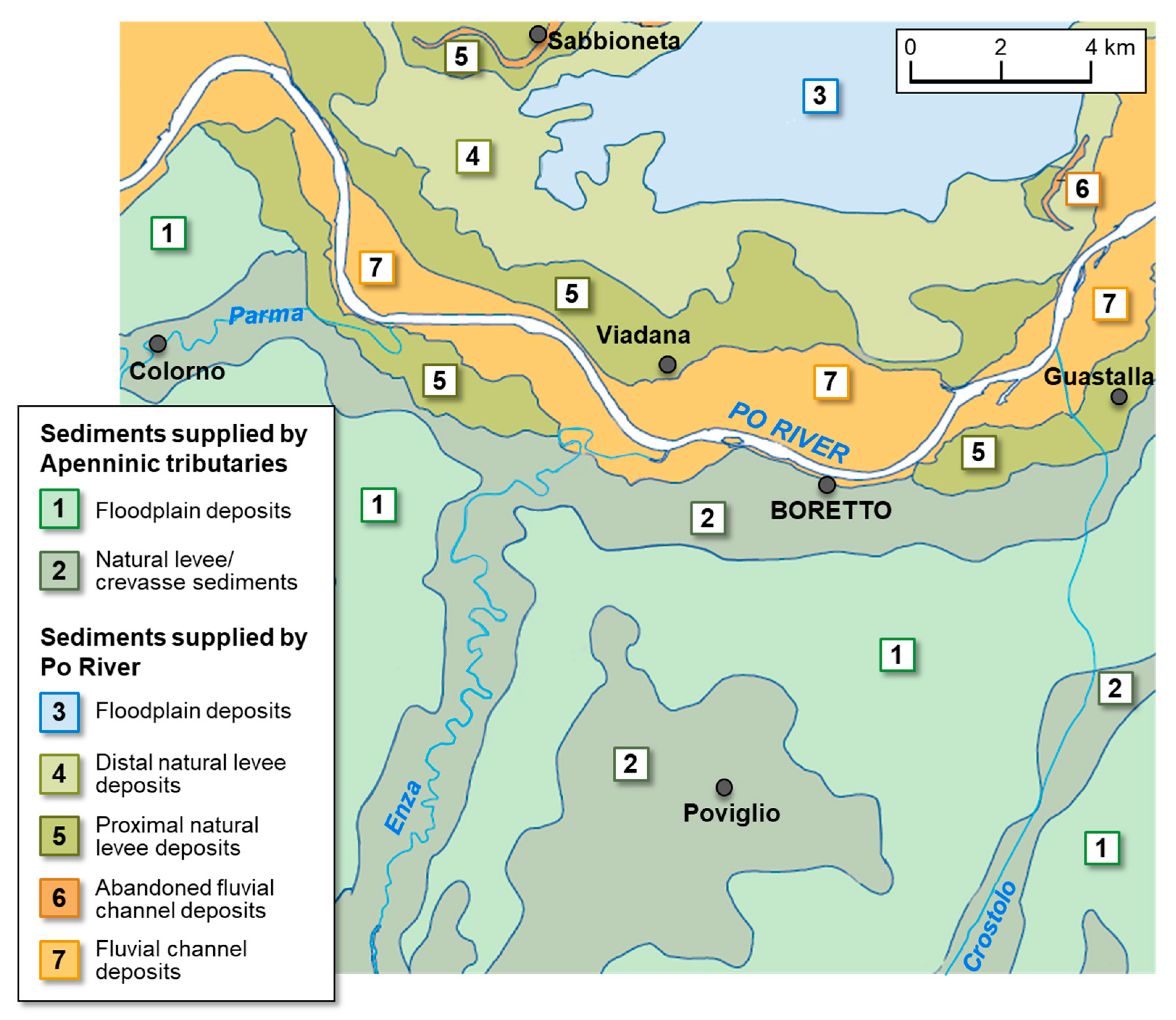

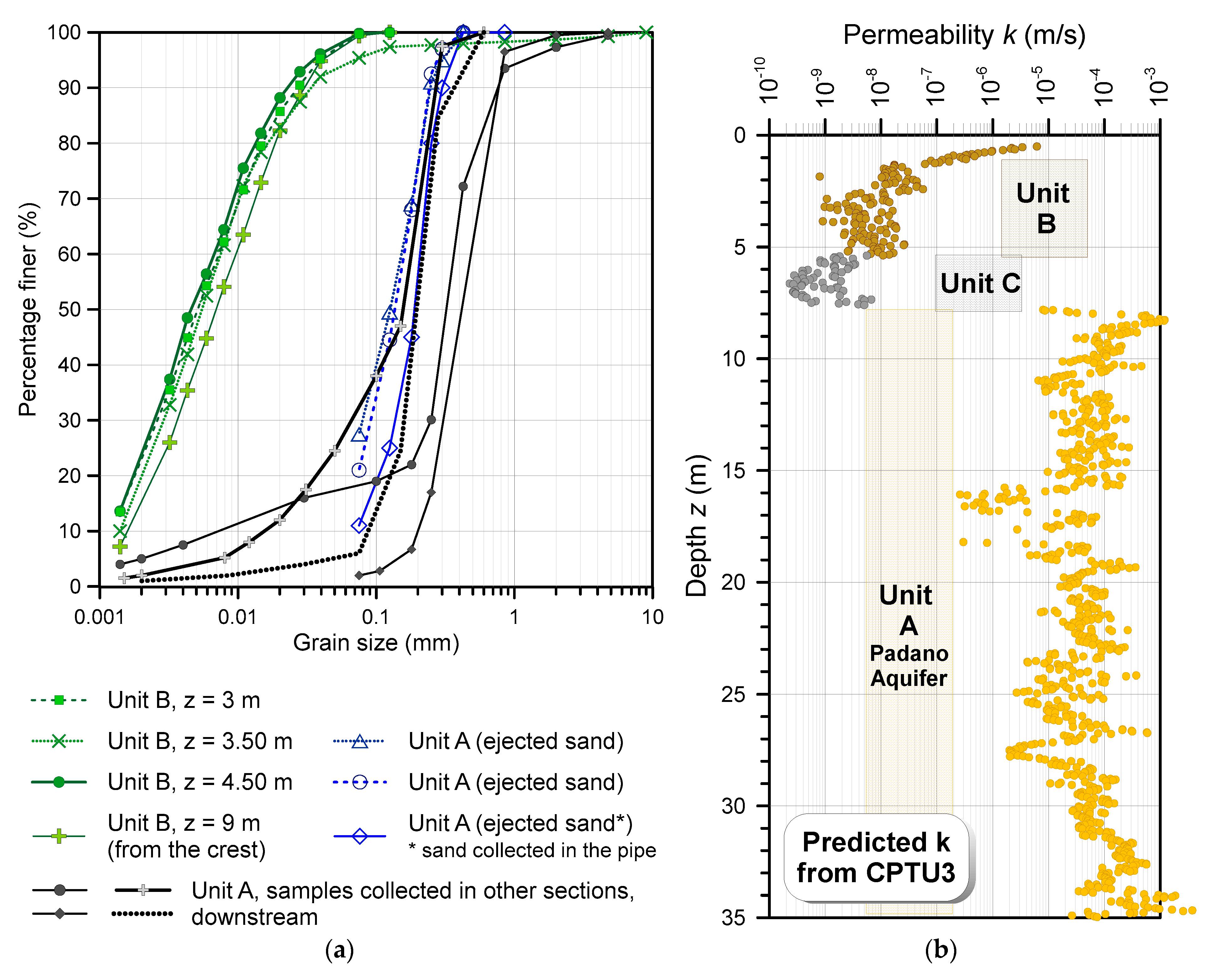


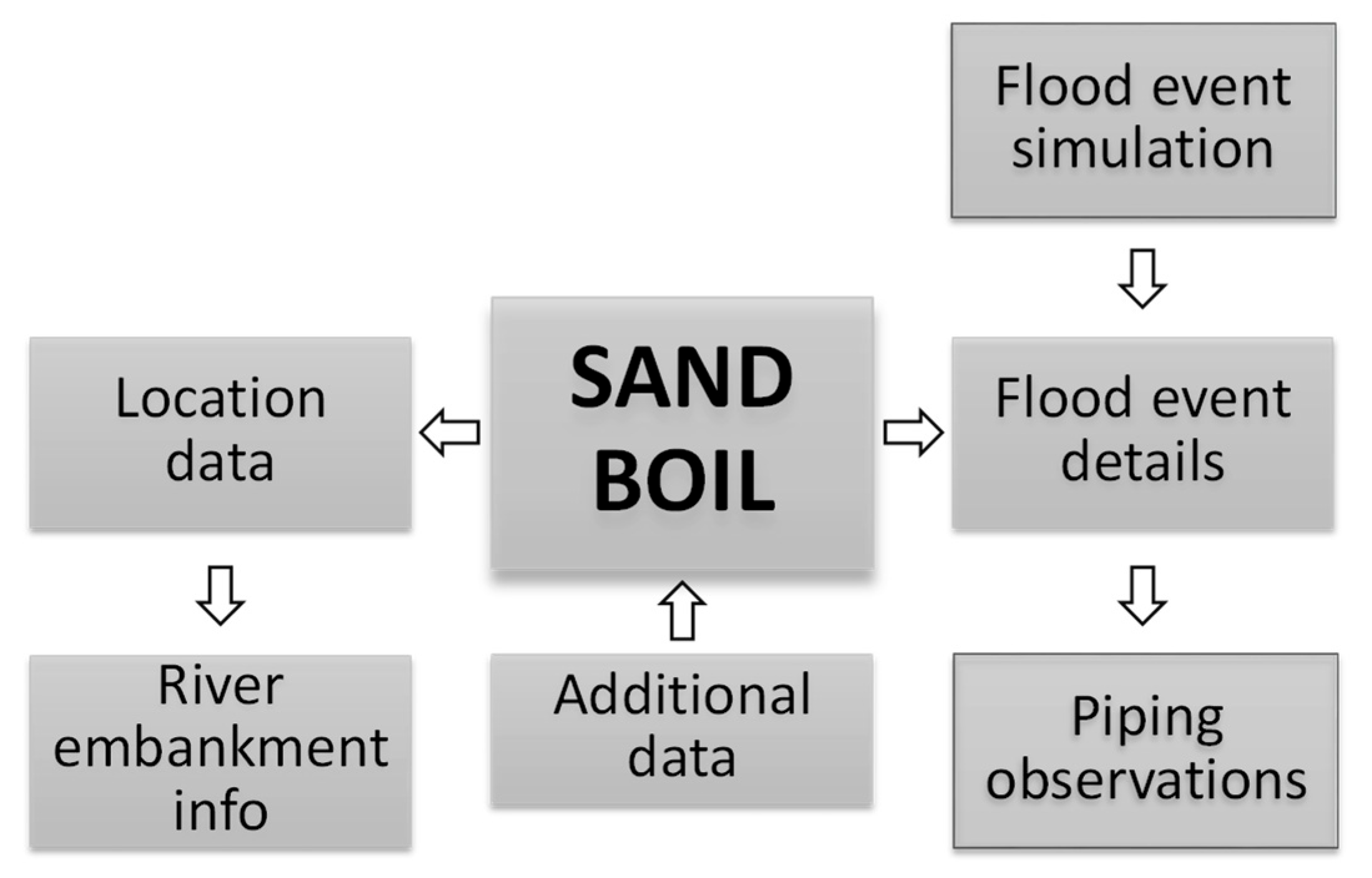









| Soil Unit | log10(k) with k Expressed in m/s | k (m/s) |
|---|---|---|
| A | −4.73 (0.65) | 1.87 × 10−5 |
| B | −7.81 (0.77) | 1.53 × 10−8 |
| C | −8.93 (0.39) | 1.17 × 10−9 |
| L1 (m) | L2 (m) | zbl (m) | d (m) | x (m) | kbl (m/s) | kf (m/s) |
|---|---|---|---|---|---|---|
| 113 | 62 | 2.62 | 30 | 52 | 1.2 × 10−9 | 1.9 × 10−5 |
| η (-) | θ (°) | γ′p (kN/m3) | d70 (mm) | κ (m2) | L (m) | ha (m) |
|---|---|---|---|---|---|---|
| 0.25 | 36.49 | 16.5 | 0.15 | 1.94 × 10−12 | 252 | 30 |
Disclaimer/Publisher’s Note: The statements, opinions and data contained in all publications are solely those of the individual author(s) and contributor(s) and not of MDPI and/or the editor(s). MDPI and/or the editor(s) disclaim responsibility for any injury to people or property resulting from any ideas, methods, instructions or products referred to in the content. |
© 2024 by the authors. Licensee MDPI, Basel, Switzerland. This article is an open access article distributed under the terms and conditions of the Creative Commons Attribution (CC BY) license (https://creativecommons.org/licenses/by/4.0/).
Share and Cite
Tonni, L.; Marchi, M.; Bassi, A.; Rosso, A. A Sand Boil Database for Piping Risk Management in the Po River, Italy. Water 2024, 16, 1384. https://doi.org/10.3390/w16101384
Tonni L, Marchi M, Bassi A, Rosso A. A Sand Boil Database for Piping Risk Management in the Po River, Italy. Water. 2024; 16(10):1384. https://doi.org/10.3390/w16101384
Chicago/Turabian StyleTonni, Laura, Michela Marchi, Agnese Bassi, and Alessandro Rosso. 2024. "A Sand Boil Database for Piping Risk Management in the Po River, Italy" Water 16, no. 10: 1384. https://doi.org/10.3390/w16101384
APA StyleTonni, L., Marchi, M., Bassi, A., & Rosso, A. (2024). A Sand Boil Database for Piping Risk Management in the Po River, Italy. Water, 16(10), 1384. https://doi.org/10.3390/w16101384






